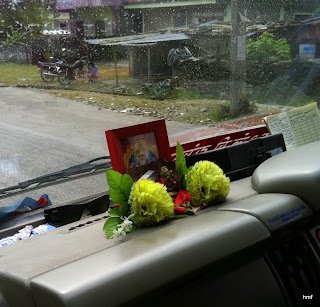Walking down the mountain onto the road to grab a cab or a bus, we begin our monastery break. After a transfer at Harichowk, we catch another bus, or van to Chipeldhunga to be dropped off at the circle right below my favorite restaurant, Almonds. Time for a walk, some purchases, and a non-veg dinner.
Riding in the front seat of the van, it is good to know the Gods are with us. On the dashboard, all vehicles in Nepal have deities with offerings; hopefully to balance out the absence of seat belts.
And the next photo on my camera, right after the assurance bit above...
Riding in the front seat of the van, it is good to know the Gods are with us. On the dashboard, all vehicles in Nepal have deities with offerings; hopefully to balance out the absence of seat belts.
And the next photo on my camera, right after the assurance bit above...
Motorbikes Abound
New Timepiece for Theresa
Fresh Popcorn Anyone?
Or Peanuts?
Deep Fried Street Food
(a definite pass)
Fresh Home Grown Vegetables
Oranges by the Kilo
(A definite yes)
Mobile Help
And now for a change of pace- Salways. The last time I was in Nepal, Salways had rats scuttling across the floor during the daytime. They're gone, so is the old floor and an expansion has tripled the store's square footage. Life is good.
Teas and Biscuits - Utter Heaven
Familiar Marketing (45 NR- about $.60)
One Nameless Volunteer's Checkout Basket
And now for that non-veg dinner at Thakali Bhanchaha, a Tibetan Restuarant in town.
Chicken Momo's (Tibetan Dumplings)
Jackson, Theresa, Andrea, and YT




















































